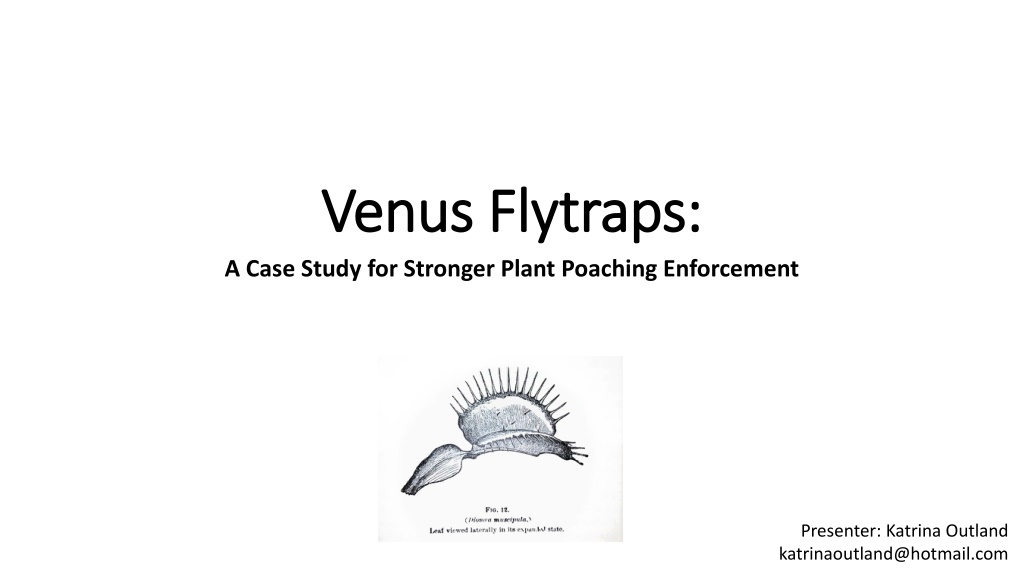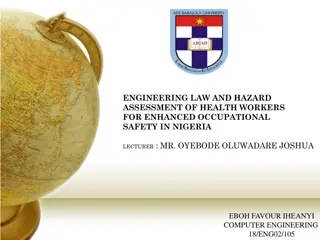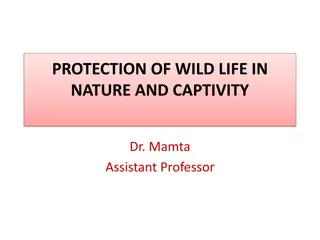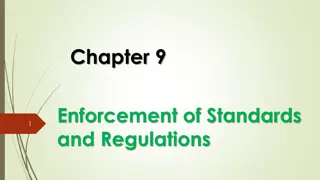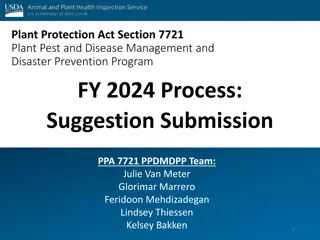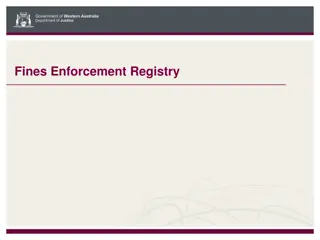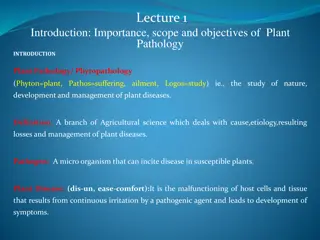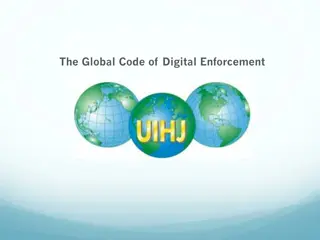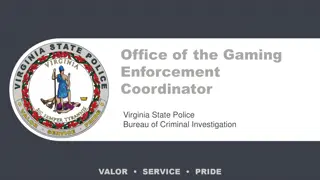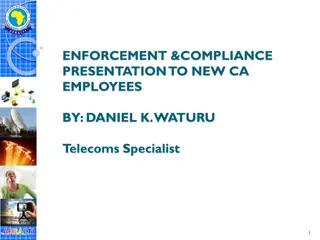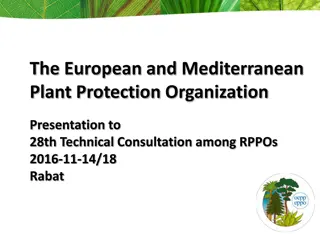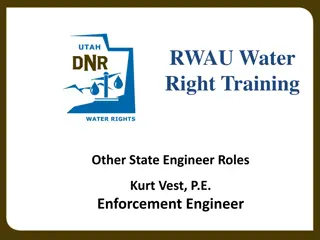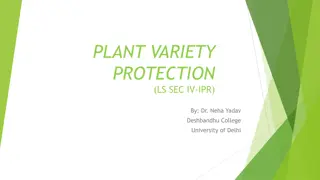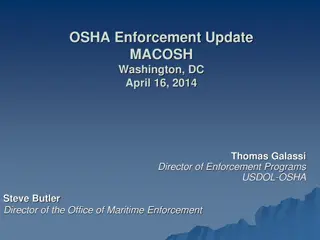Plant Poaching Enforcement: A Case Study for Stronger Protection Laws
Understanding the importance of enforcing plant protection laws to combat illegal plant trade, this case study delves into the basics of poaching, the Lacey Act, challenges, and practical solutions. It discusses the global impact of plant poaching due to poverty and organized crime, highlighting the need for prosecution as a deterrent and for safeguarding biodiversity and ecosystems. Additionally, it provides insights into relevant laws like CITES, the Endangered Species Act, and state laws governing plant protection.
Download Presentation

Please find below an Image/Link to download the presentation.
The content on the website is provided AS IS for your information and personal use only. It may not be sold, licensed, or shared on other websites without obtaining consent from the author. Download presentation by click this link. If you encounter any issues during the download, it is possible that the publisher has removed the file from their server.
E N D
Presentation Transcript
Venus Venus Flytraps: Flytraps: A Case Study for Stronger Plant Poaching Enforcement Presenter: Katrina Outland katrinaoutland@hotmail.com
Overview Poaching basics Plant protection laws & Lacey Act basics Example of Lacey Act in action United States v. J & L Tonewoods Venus flytraps & proposed way to use Lacey Act Practical issues & hurdles to overcome
Poaching is? Working definition: Black s Law: Illegal taking or killing of fish & game on another s land (not plants) The intentional collecting or killing of plant or animal without lawful permission Taking = very broad, i.e., could include unintentional harm (trampling, development)
poverty global illegal wildlife/plant trade estimated $200 billion/year, only outranked by international drug trade rebellion thrill Why organized crime Poach? culture trophy
Why Prosecute Plant Poaching? deterrence send strong message ties with other crimes allow opportunities for diversion, connect to support services protect businesses that deal fairly prevent spread of invasive species or disease protect plants themselves & ecosystem biodiversity, local culture, interlinked species carnivorous plants prevent spread of insect-vector diseases
Brief Brief Overview of Overview of Plant Laws Plant Laws CITES(Convention on Int l Trade in Endangered Species of Wild Fauna and Flora) Endangered Species Act; Lacey Act State Laws
Endangered Species Act Only protects plants on federal land Only protects from actual possession or intentional violations of state laws Difficult to enforce Publishing Critical Areas can cause more harm Slow and difficult to get listed Rock Gnome Lichen. Photo: Hugh & Carol Nourse
State Laws Washington s Specialized Forest Products Act: state permit for harvesting; buyers must check & record permits from sellers. Arizona Native Plants Act: Permits for taking, transporting, or possessing native plants only issued for scientific or noncommercial salvage; wild saguaro cacti given additional protections. A.R.S. 3-906. Texas Endangered Plants: Permit needed by each person for commercial taking, possessing, transporting, or selling any part of listed plant on private land, AND each plant has to be tagged. These activities prohibited if the plant is from public land. Vernon s Tex. Stat. C. 88.008
Lacey Act Plant provisions greatly strengthened in 2008 amendments Prohibits 3 types of acts: 1. import foreign plants improperly. 16 USC 3372(f) 2. falsely labeling plants for foreign or interstate commerce. 16 USC 3372(d) 3. other : selling, receiving, acquiring, or purchasing of any plant taken or possessed in violation of federal, tribal, state, or foreign law; legal harvest but transported without paying required fee/tax. 16 USC 3372(a)
Example case of Lacey Act in action
United States v. J & L Tonewoods Lumber mill J & L Tonewoods bought big leaf maple taken from Gifford Pinchot National Forest Charged 3 maple cutters for theft & damage to government property Charged the company & sole owner for knowingly buying stolen maple Lacey Act violation! 3372(a)(2)(B) & 3373(d). Profited >$800,000 from stolen maple in 2 years. Indicted then settled Screenshot of Google image search: figured maple
Lacey Act Target Dealer State Law 16 USC 3372(a)(2)(B): WA Specialized Forest Products Act, RCW 76.48.031 need state permit for harvesting listed knowingly engage in conduct that involved the sale & purchase of plants knowingly sell & transport said plants in interstate commerce, knowing that [they had been taken] in violation of Purchaser must record the seller s permit! plants state law. RCW 76.48.111 16 USC 3373(d): (also) 18 USC 641, 2: receipt of stolen federal property sold & transported maple knowing it had been taken in violation of state law
Venus Flytrap (Dionae muscipula) Unique species Native only to one region of North & South Carolina Currently pending listing as endangered species High demand by collectors & for use in pseudo-science tonics Photo by Noah Elhardt
North Carolinas Venus flytrap laws Felony taking: [a]ny person, firm, or corporation who digs up, pulls up, takes, or carries away. . . any Venus flytrap [plant or seed]. . . growing upon the lands of another person, or from the public domain, with the intent to steal. N.C. Gen. Stat 145-22. Penalty increased: old max. misdemeanor $50 4 to 30 months prison Plant Conservation Laws: Collector s permit must be in person s possession at the time they dig, pull, take, or carry away the flytrap. N.C. Gen. State 14-129.3(b).
Case Updates Few prosecutions under felony law Enforcement still has to catch poachers in the act Some deterrence? Plant surveys 2013-2017 in Green Swamp Preserve Nature Conservancy Flytrap Surveys 0.9 0.8 0.7 0.6 0.5 0.4 0.3 0.2 0.1 0 year that felony law was passed 2013 2014 2015 2016 2017 Percentage of Poached Plots Surveys conducted by Roger Shew of University of North Carolina Wilmington
216 counts https://portcitydaily.com/local-news/2019/03/18/man-charged- with-73-counts-of-poaching-venus-flytrap-bond-at-750000/
How to Equitably Curb Poaching? Stronger deterrence, but reinforces cycle of poverty Layer 1: Tougher penalties Layer 2: Prove buyer s criminal intent Track plants, greater protection for wild populations Layer 3: Aim Lacey Act at buyers Shift burden of crime to those making more profits & driving the market
Lacey Act Target Dealer State Law 16 USC 3373(d): Civil: buyer didn t use due care to make sure flytraps weren t illegally taken/possessed. NC 106-202.19(a)(6a): NC 145-22: poacher doesn t have required permit NC 106- 202.19(a)(6c): Poacher digs up & carries away Venus flytraps from state park with intent to Misdemeanor: buyer sells/buys flytraps (or intends to) and using due care should know plants were taken illegally. Dealer buys flytraps outside of buying season without getting the poacher s permit steal Felony: Buyer knew the plants were taken illegally
How to Track Where Plants Came From? Require buyers to maintain records of their sources permits (like WA s Specialized Forest Products Act) Require buyers to get & maintain their own permits (like ginseng) Biological marking system? fluorescent dye in ginseng roots DNA matching stolen lumber to stumps orange dye on Green Swamp Preserve flytraps
Sources & Extra Materials Arizona Native Plants Act: A.R.S. 3-901 et seq. Wallace v. Shields, 854 P.2d 1152 (Ct. App. Ari., 1992): Wallaces owned crested saguaro cacti that had allegedly been stolen from public and private land. Upheld state agency s authority for seizing the plants, but lack of post-seizure hearing on whether cacti were likely stolen unconstitutionally denied the Wallaces due process. Vanessa Dick, DIRTY MONEYAND WILDLIFE TRAFFICKING USINGTHE MONEY LAUNDERING CONTROL ACT, 49 Envtl. L. Rep. News & Analysis 20334 (2019). (proposes a way to link wildlife trafficking and financial crimes through the Lacey Act and the Money Laundering Control Act to target harsher penalties at organized crime kingpins. Unfortunately, the law doesn t currently include plant trafficking). Makenzie Holland & Tim Buckland, Trying to Keep Venus Flytrap Poachers at Bay, JD NEWS (Mar. 27, 2018). Christina M. Russo, CRIMINAL PROSECUTIONFOR ENVIRONMENTAL LAWBREAKERS: A STATUTEWITH NO BITE, 28 Vill. Envtl. L.J. 97 (2017). (largely criticizes federal environmental crime prosecution but argues that more consistent sentencing will lead to stronger deterrence). Marcus A. Asner, TO CATCHA WILDLIFE THIEF: STRATEGIESAND SUGGESTIONSFORTHE FIGHT AGAINST ILLEGAL WILDLIFE TRAFFICKING, 12 U. Penn. Asian L. Rev. 1 (2017) (practical breakdown & suggestions for gathering evidence and building a case in large-scale wildlife trafficking rings). Ursula Ramsey, COMMUNITY ORCHARDSAND FOOD SECURITYIN APPALACHIA, 120 W. Va. L. Rev. 1063 (2018). (more insight into level of poverty in Appalachia)
